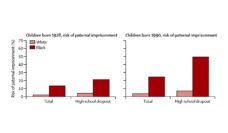The prison setting is a uniquely challenging work environment, with employees facing constant exposure to threat, violence, and trauma. Previous research has shown that prison employees are at high risk for serious psychological distress leading to the development of mental illness such as depression and anxiety. Another serious concern for prison employees is post-traumatic stress disorder (PTSD). “Trauma” within the PTSD context generates from an event or series of events from which the person feels like they cannot escape. This trauma can result from direct experience of grievous injury or sexual violence. Or it could come from witnessing such events or death. Prison employees, particularly correction officers, are at high risk for both routinely witnessing trauma and potentially experiencing it themselves.
The goal of our study was to investigate the prevalence of PTSD among prison employees and explore risk and protective factors. We surveyed 355 Washington state prison employees using a comprehensive questionnaire designed to assess the physical and psychological risks of prison work. Included in the questionnaire were the PTSD checklist from the Diagnostic and Statistical Manual of Mental Disorders (Fifth Edition), the Critical Incident History Questionnaire, and the Work Environment Inventory. We estimated PTSD rates and symptoms, explored risk factors associated with higher PTSD scores, and investigated protective factors associated with lower PTSD scores.
Nineteen percent of respondents met the diagnostic criteria for PTSD—a rate six times higher than the general population, comparable to Iraq and Afghanistan war veterans.
The majority of the sample was male (65%) and white (81%). Most participants were correction officers (65%) working in male inmate facilities (63%). Nineteen percent of respondents met the diagnostic criteria for PTSD—a rate six times higher than the general population, comparable to Iraq and Afghanistan war veterans. Symptoms that stood out were nightmares related to work events (15%), avoiding reminders of workplace trauma (14%), and disturbing flashbacks (10%). Female employees, Black employees, day-shift employees, and employees with more years of experience reported higher rates of PTSD.
Significant risk factors for PTSD included being seriously injured at work and dealing with inmates who had been recently sexually assaulted. Work frustrations including feeling like the prison puts the employees in unnecessary danger and lack of clarity about job roles were also significantly associated with higher PTSD rates. Several factors, however, were found to be protective against PTSD. These included being happy with work assignments, having good relationships with supervisors, and having positive relationships with coworkers.
The results of this study have several important implications. First, given the high prevalence of PTSD among prison employees, interventions for promoting resilience to trauma in this population are clearly needed. Second, given that some prison employees are at greater risk (e.g. woman), interventions need to address specific needs of certain prison employee subgroups. Third, more research is needed to understand why certain groups of prison employees are at greater risk, and what types of interventions are the most promising for addressing this critical problem. We urge researchers to focus on this critical problem, and the corrections profession to adopt trainings and interventions that promote resilience to the harmful effects of working behind the walls.
Feature image: HakuNellies/iStock, used for illustrative purposes only.













